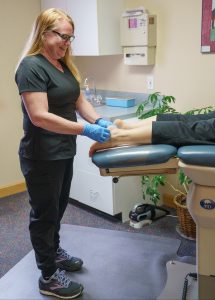Patient Education: Foot Treatment and Diagnosis
 Ankle & Foot Associates provide comprehensive medical and surgical care for a wide spectrum of foot and ankle conditions. Whether you have a common or a complex disorder, they help patients of all ages manage their foot conditions.
Ankle & Foot Associates provide comprehensive medical and surgical care for a wide spectrum of foot and ankle conditions. Whether you have a common or a complex disorder, they help patients of all ages manage their foot conditions.
Our staff is also uniquely qualified to detect the early stages of diseases that exhibit warning signs in the lower extremities, such as diabetes, arthritis, and cardiovascular disease. We can also help you manage foot conditions which may pose an ongoing threat to your overall health.
The following disorders are among the most common that we help treat at Ankle & Foot Associates. You may find this information helpful to identify your own foot treatment and diagnosis:
Achilles Tendon
A tendon is a band of tissue that connects a muscle to a bone. The Achilles tendon runs down the back of the lower leg and connects the calf muscle to the heel bone. Also called the “heel cord,” the Achilles tendon facilitates… Learn More > >
Bunions
Even though bunions are a common foot deformity, there are misconceptions about them. Many people may unnecessarily suffer the pain of bunions for years before seeking treatment… Learn More >>
Diabetes
Having diabetes increases the risk of developing a wide range of foot problems, often because of two complications of the disease: nerve damage (neuropathy) and poor circulation… Learn More >>
Fractures
To diagnose a fracture, the foot and ankle surgeon will ask questions about how the injury occurred, examine the affected foot and ankle, and order x-rays. In addition, advanced imaging tests are commonly required… Learn More >>
Gout
Gout is a disorder that results from the build-up of uric acid in the tissues or a joint. It most often affects the joint of the big toe… Learn More > >
Hammertoes
Hammertoe is a contracture (bending) of one or both joints of the second, third, fourth, or fifth (little) toes. This abnormal bending can put pressure on the toe when wearing shoes, causing problems to develop… Learn More >>
Heel Pain and Plantar Fasciitis
Heel pain is most often caused by plantar fasciitis, a condition that is sometimes also called heel spur syndrome when a spur is present. Heel pain may also be due to other causes, such as a stress fracture, tendonitis, arthritis… Learn More >>
Ingrown Toenails
When a toenail is ingrown, it is curved and grows into the skin, usually at the nail borders (the sides of the nail). This “digging in” of the nail irritates the skin, often creating pain, redness, swelling, and warmth in the toe… Learn More >>
Neuroma
The thickening, or enlargement, of the nerve that defines a neuroma, is the result of compression and irritation of the nerve. This compression creates an enlargement of the nerve, eventually leading to permanent nerve damage… Learn More >>
